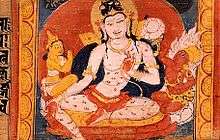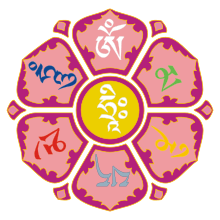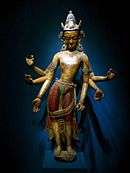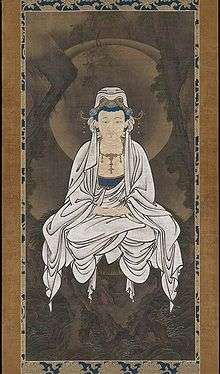Avalokiteśvara
| Part of a series on |
| Buddhism |
|---|
 |
|
Avalokiteśvara (Sanskrit, "Lord who looks down", Tibetan: སྤྱན་རས་གཟིགས་, Wylie: spyan ras gzigs , THL: Chenrézik) is a bodhisattva who embodies the compassion of all Buddhas. This bodhisattva is variably depicted and described and is portrayed in different cultures as either female or male.[1] In Chinese Buddhism, Avalokiteśvara has become the somewhat different female figure Guanyin. In Cambodia, he appears as Lokeśvara.
Avalokiteśvara is one of the more widely revered bodhisattvas in mainstream Mahayana Buddhism as well as unofficially in Theravada Buddhism.[1]
Etymology
The name Avalokiteśvara combines the verbal prefix ava "down", lokita, a past participle of the verb lok "to notice, behold, observe", here used in an active sense; and finally īśvara, "lord", "ruler", "sovereign" or "master". In accordance with sandhi (Sanskrit rules of sound combination), a+iśvara becomes eśvara. Combined, the parts mean "lord who gazes down (at the world)". The word loka ("world") is absent from the name, but the phrase is implied.[2] It does appear in the Cambodian form of the name, Lokeśvara.
The earliest translation of the name into Chinese by authors such as Xuanzang was Guānzìzài (Chinese: 觀自在), not the form used in East Asian Buddhism today, Guanyin (Chinese: 觀音). It was initially thought that this was due to a lack of fluency, as Guanzizai indicates the original Sanskrit form was actually Avalokitasvara, "who looks down upon sound" (i.e., the cries of sentient beings who need help).[3] It is now understood that was the original form,[4][5] and is also the origin of Guanyin "Perceiving sound, cries", a translation furthered by the tendency of some Chinese translators, notably Kumārajīva, to use the variant 觀世音 Guānshìyīn "who perceives the world's lamentations"—wherein lok was read as simultaneously meaning both "to look" and "world" (Sanskrit loka; Chinese: 世; pinyin: shì).[3] The original form Avalokitasvara appears in Sanskrit fragments of the fifth century.[6]
This earlier Sanskrit name was supplanted by the form containing the ending -īśvara "lord"; Avalokiteśvara does not occur in Sanskrit before the seventh century.
The original meaning of the name fits the Buddhist understanding of the role of a bodhisattva. The reinterpretation presenting him as an īśvara shows a strong influence of Hinduism, as the term īśvara was usually connected to the Hindu notion of Krishna (in Vaishnavism) or Śiva (in Shaivism) as the Supreme Lord, Creator and Ruler of the world. Some attributes of such a god were transmitted to the bodhisattva, but the mainstream of those who venerated Avalokiteśvara upheld the Buddhist rejection of the doctrine of any creator god.[7]
In Sanskrit, Avalokiteśvara is also referred to as Padmapāni ("Holder of the Lotus") or Lokeśvara ("Lord of the World"). In Tibetan, Avalokiteśvara is Chenrézik, (Tibetan: སྤྱན་རས་གཟིགས་ ) and is said to emanate as the Dalai Lama[8] the Karmapa[9][10] and other high lamas. An etymology of the Tibetan name Chenrézik is spyan "eye", ras "continuity" and gzig "to look". This gives the meaning of one who always looks upon all beings (with the eye of compassion).[11]
Origin

Mahayana Account
According to Mahāyāna doctrine, Avalokiteśvara is the bodhisattva who has made a great vow to assist sentient beings in times of difficulty and to postpone his own buddhahood until he has assisted every sentient being in achieving nirvana. Mahayana sutras associated with Avalokiteśvara include the following:
- Lotus Sutra
- Kāraṇḍavyūhasūtra
- Heart Sutra (Heart Sūtra)
- Nīlakaṇṭha Dhāraṇī Sutra
- Eleven-Faced Avalokitesvara Heart Dharani Sutra
- Cundī Dhāraṇī Sūtra
The Lotus Sutra is generally accepted to be the earliest literature teaching about the doctrines of Avalokiteśvara.[12] These are found in the Lotus Sutra chapter 25 (Chinese: 觀世音菩薩普門品). This chapter is devoted to Avalokiteśvara, describing him as a compassionate bodhisattva who hears the cries of sentient beings, and who works tirelessly to help those who call upon his name. A total of 33 different manifestations of Avalokiteśvara are described, including female manifestations, all to suit the minds of various beings. The chapter consists of both a prose and a verse section. This earliest source often circulates separately as its own sutra, called the Avalokiteśvara Sūtra (Chinese: 觀世音經; pinyin: Guānshìyīn jīng), and is commonly recited or chanted at Buddhist temples in East Asia.[13]
When the Chinese monk Faxian traveled to Mathura in India around 400 CE, he wrote about monks presenting offerings to Avalokiteśvara.[14] When Xuanzang traveled to India in the 7th century, he provided eyewitness accounts of Avalokiteśvara statues being venerated by devotees of all walks of life, from kings, to monks, to laypeople.[14] Avalokiteśvara remained popular in India until the 12th century when Muslim invaders conquered the land and destroyed Buddhist monasteries.[14]
In Chinese Buddhism and East Asia, Tangmi practices for the 18-armed form of Avalokiteśvara called Cundī are very popular. These practices have their basis in early Indian Vajrayana: her origins lie with a yakshini cult in Bengal and Orissa and her name in Sanskrit "connotes a prostitute or other woman of low caste but specifically denotes a prominent local ogress ... whose divinised form becomes the subject of an important Buddhist cult starting in the eighth century".[15] The popularity of Cundī is attested by the three extant translations of the Cundī Dhāraṇī Sūtra from Sanskrit to Chinese, made from the end of the seventh century to the beginning of the eighth century.[16] In late imperial China, these early esoteric traditions still thrived in Buddhist communities. Robert Gimello has also observed that in these communities, the esoteric practices of Cundī were extremely popular among both the populace and the elite.[17]
In the Tiantai school, six forms of Avalokiteśvara are defined. Each of the bodhisattva's six qualities are said to break the hindrances respectively of the six realms of existence: hell-beings, pretas, animals, humans, asuras, and devas.

Theravāda Account

Veneration of Avalokiteśvara Bodhisattva has continued to the present day in Sri Lanka, where he is called Nātha.[18] In more recent times, some western-educated Theravādins have attempted to identify Nātha with Maitreya Bodhisattva. However, traditions and basic iconography, including an image of Amitābha Buddha on the front of the crown, identify Nātha as Avalokiteśvara.[19] Andrew Skilton writes:[20]
... It is clear from sculptural evidence alone that the Mahāyāna was fairly widespread throughout [Sri Lanka], although the modern account of the history of Buddhism on the island presents an unbroken and pure lineage of Theravāda. (One can only assume that similar trends were transmitted to other parts of Southeast Asia with Sri Lankan ordination lineages.) Relics of an extensive cult of Avalokiteśvara can be seen in the present-day figure of Nātha.
Avalokiteśvara is popularly worshiped in Myanmar, where he is called Lokanat, and Thailand, where he is called Lokesvara.

Modern scholarship

Western scholars have not reached a consensus on the origin of the reverence for Avalokiteśvara.
Some have suggested that Avalokiteśvara, along with many other supernatural beings in Buddhism, was a borrowing or absorption by Mahayana Buddhism of one or more deities from Hinduism, in particular Shiva or Vishnu, although the reason for this suggestion is because of the current name of the bodhisattva: Avalokiteśvara.[6]
The Japanese scholar Shu Hikosaka on the basis of his study of Buddhist scriptures, ancient Tamil literary sources, as well as field survey, proposes the hypothesis that, the ancient mount Potalaka, the residence of Avalokiteśvara described in the Gaṇḍavyūha Sūtra and Xuanzang’s Great Tang Records on the Western Regions, is the real mountain Pothigai in Ambasamudram, Tirunelveli, Tamil Nadu.[21] Shu also says that mount Potalaka has been a sacred place for the people of South India from time immemorial. With the spread of Buddhism in the region beginning at the time of the great king Aśoka in the third century BCE, it became a holy place also for Buddhists who gradually became dominant as a number of their hermits settled there. The local people, though, mainly remained followers of the Hindu religion. The mixed Hindu-Buddhist cult culminated in the formation of the figure of Avalokiteśvara.[22]
The name Lokeśvara should not be confused with that of Lokeśvararāja, the Buddha under whom Dharmakara became a monk and made forty-eight vows before becoming Amitābha.
Mantras and Dharanis

Mahāyāna Buddhism relates Avalokiteśvara to the six-syllable mantra oṃ maṇi padme hūṃ. In Tibetan Buddhism, due to his association with this mantra, one form of Avalokiteśvara is called Ṣaḍākṣarī "Lord of the Six Syllables" in Sanskrit. Recitation of this mantra along with prayer beads is the most popular religious practice in Tibetan Buddhism.[23] The connection between this famous mantra and Avalokiteśvara occurs for the first time in the Kāraṇḍavyūhasūtra. This text is first dated to around the late 4th century CE to the early 5th century CE.[24] In this sūtra, a bodhisattva is told by the Buddha that recitation of this mantra while focusing on the sound can lead to the attainment of eight hundred samādhis.[25] The Kāraṇḍavyūha Sūtra also features the first appearance of the dhāraṇī of Cundī, which occurs at the end of the sūtra text.[16] After the bodhisattva finally attains samādhi with the mantra "oṃ maṇipadme hūṃ", he is then able to observe 77 koṭīs of fully enlightened buddhas replying to him in one voice with the Cundī Dhāraṇī: namaḥ saptānāṃ samyaksaṃbuddha koṭīnāṃ tadyathā, oṃ cale cule cunde svāhā.[26]
In Shingon Buddhism, the mantra for Avalokiteśvara is On aruri kya sowa ka (Japanese: おん あるりきゃ そわか)
The Nīlakaṇṭha Dhāraṇī is an 82-syllable dhāraṇī for Avalokiteśvara.
Thousand-armed Avalokiteśvara
One prominent Buddhist story tells of Avalokiteśvara vowing never to rest until he had freed all sentient beings from saṃsāra. Despite strenuous effort, he realizes that still many unhappy beings were yet to be saved. After struggling to comprehend the needs of so many, his head splits into eleven pieces. Amitābha, seeing his plight, gives him eleven heads with which to hear the cries of the suffering. Upon hearing these cries and comprehending them, Avalokiteśvara attempts to reach out to all those who needed aid, but found that his two arms shattered into pieces. Once more, Amitābha comes to his aid and invests him with a thousand arms with which to aid the suffering multitudes.[27]
The Bao'en Temple located in northwestern Sichuan has an outstanding wooden image of the Thousand-Armed Avalokiteśvara, an example of Ming dynasty decorative sculpture.[28][29]
Tibetan Buddhist Beliefs Concerning Chenrezig
Avalokiteśvara is an important deity in Tibetan Buddhism, and is regarded in the Vajrayana teachings as a Buddha.[30]
In Tibetan Buddhism, Tara came into existence from a single tear shed by Avalokiteśvara.[1] When the tear fell to the ground it created a lake, and a lotus opening in the lake revealed Tara. In another version of this story, Tara emerges from the heart of Avalokiteśvara. In either version, it is Avalokiteśvara's outpouring of compassion which manifests Tara as a being[31][32][33]
Manifestations
Avalokiteśvara has an extraordinarily large number of manifestations in different forms (including wisdom goddesses (vidyaas) directly associated with him in images and texts). Some of the more commonly mentioned forms include:
| Sanskrit | Meaning | Description |
|---|---|---|
| Aryavalokitesvara | Sacred Avalokitesvara | The root form of the Bodhisattva |
| Ekādaśamukha | Eleven Faced | Additional faces to teach all in 10 planes of existence |
| Sahasra-bhuja Sahasra-netra | Thousand-Armed, Thousand-Eyed Avalokitesvara | Very popular form: sees and helps all |
| Cintamāṇicakra | Wish Fulfilling Avalokitesvara | Holds the bejeweled cintamani wheel |
| Hayagrīva | Horse-necked one | Wrathful form; simultaneously bodhisattva and a Wisdom King |
| Cundi | "prostitute or other woman of low caste"[15] | Portrayed with many arms |
| Amoghapāśa | Unfailing Rope | Avalokitesvara with rope and net |
| Bhrkuti | Fierce-Eyed | |
| Pāndaravāsinī | White and Pure | |
| Parnaśabarī | Cloaked With Leaves | |
| Raktaṣadakṣarī | Six Red Syllables | |
| Śvetabhagavatī | White Lord | |
| Udakaśrī | Auspicious Water |
Gallery
-

Indian cave wall painting of Avalokiteśvara. Ajaṇṭā Caves, 6th century CE.
-

Torso of Avalokiteśvara from Sanchi in the Victoria and Albert Museum
-

Cambodian statue of Avalokiteśvara. Sandstone, 7th century CE.
-

Avalokiteshvara sandstone statue, late 7th century CE.
-

Padmapani holding a lotus. 8th-9th century Sailendran art, Plaosan temple, Java, Indonesia.
-

Eight-armed Avalokiteshvara, ca. 12th-13th century (Bàyon). The Walters Art Museum.
-
Avalokiteshvara from Bingin Jungut, Musi Rawas, South Sumatra. Srivijayan art (c. 8th-9th century CE)
-
The bronze torso statue of Padmapani, 8th century CE Srivijayan art, Chaiya, Surat Thani, Southern Thailand.
-
The stone head of Avalokiteshvara Bodhisattva, discovered in Aceh. Srivijayan art, estimated 9th century CE.
-

Chinese statue of Avalokiteśvara looking out over the sea, c. 1025 CE.
-

Chinese hanging scroll depicting Shancai, Avalokiteśvara and Longnü, Yuan Dynasty.
-

Korean painting of Avalokiteśvara. Kagami Jinjya, Japan, 1310 CE.
-

Nepalese statue of Avalokiteśvara with six arms. 14th century CE.
-

Japanese painting of meditating. 16th century CE.
-

Avalokiteśvara, crimson and gilded wood. Restored in 1656 CE. Bút Tháp Temple, Bắc Ninh Province, Vietnam
-

Tibetan statue of Avalokiteśvara with eleven faces.
-

Malaysia Kek Lok Si Temple in Air Itam, Penang. The world tallest octagonal pavilion to shelter the Goddess of Mercy statue.
-

Esoteric Cundī form of Avalokiteśvara with eighteen arms.
-

Thousand-armed Avalokiteśvara bronze statue from Tibet, circa 1750. Birmingham Museum of Art
-
Mongolian statue of Avalokiteśvara (Migjid Janraisig). Tallest indoor statue in the world, 26.5-meter-high, 1996 rebuilt, (1913)
-

Avalokiteśvara in the form of Cintamani Wheel Avalokiteśvara. A dhāraṇī written in Sanskrit in the Siddhaṃ script behind. Singapore.
See also
Notes
- 1 2 3 Leighton, Taigen Dan (1998). Bodhisattva Archetypes: Classic Buddhist Guides to Awakening and Their Modern Expression. New York: Penguin Arkana. pp. 158–205. ISBN 0140195564. OCLC 37211178.
- ↑ Studholme p. 52-54, 57.
- 1 2 Pine, Red. The Heart Sutra: The Womb of the Buddhas (2004) Shoemaker 7 Hoard. ISBN 1-59376-009-4 pg 44-45
- ↑ Lokesh Chandra (1984). "The Origin of Avalokitesvara" (PDF). Indologica Taurinenaia (International Association of Sanskrit Studies). XIII (1985-1986): 189–190. Archived from the original (PDF) on June 6, 2014. Retrieved 26 July 2014.
- ↑ Mironov, N. D. (1927). "Buddhist Miscellanea". Journal of the Royal Asiatic Society of Great Britain and Ireland 2: 241–252.
- 1 2 Studholme p. 52-57.
- ↑ Studholme p. 30-31, 37-52.
- ↑ "From Birth to Exile". The Office of His Holiness the Dalai Lama. Archived from the original on 20 October 2007. Retrieved 2007-10-17.
- ↑ Martin, Michele (2003). "His Holiness the 17th Gyalwa Karmapa". Music in the Sky: The Life, Art, and Teachings of the 17th Karmapa. Karma Triyana Dharmachakra. Archived from the original on 14 October 2007. Retrieved 2007-10-17.
- ↑ "Glossary". Dhagpo Kundreul Ling. Archived from the original on 2007-08-08. Retrieved 2007-10-17.
- ↑ Bokar Rinpoche (1991). Chenrezig Lord of Love - Principles and Methods of Deity Meditation. San Francisco, California: Clearpoint Press. p. 15. ISBN 0-9630371-0-2.
- ↑ Huntington, John (2003). The Circle of Bliss: Buddhist Meditational Art: p. 188
- ↑ Baroni, Helen (2002). The Illustrated Encyclopedia of Zen Buddhism: p. 15
- 1 2 3 Ko Kok Kiang. Guan Yin: Goddess of Compassion. 2004. p. 10
- 1 2 Lopez 2013, p. 204.
- 1 2 Studholme, Alexander (2002). The Origins of Oṃ Maṇipadme Hūṃ: A Study of the Kāraṇḍavyūha Sūtra: p. 175
- ↑ Jiang, Wu (2008). Enlightenment in Dispute: The Reinvention of Chan Buddhism in Seventeenth-Century China: p. 146
- ↑ Baruah, Bibhuti. Buddhist Sects and Sectarianism. 2008. p. 137
- ↑ "Art & Archaeology - Sri Lanka - Bodhisattva Avalokiteshvara".
- ↑ Skilton, Andrew. A Concise History of Buddhism. 2004. p. 151
- ↑ Hirosaka, Shu. The Potiyil Mountain in Tamil Nadu and the origin of the Avalokiteśvara cult
- ↑ Läänemets, Märt (2006). "Bodhisattva Avalokiteśvara in the Gandavyuha Sutra". Chung-Hwa Buddhist Studies. Retrieved 2009-09-12.
- ↑ Studholme, Alexander (2002). The Origins of Oṃ Maṇipadme Hūṃ: A Study of the Kāraṇḍavyūha Sūtra: p. 2
- ↑ Studholme, Alexander (2002) The Origins of Oṃ Maṇipadme Hūṃ: A Study of the Kāraṇḍavyūha sūtra: p. 17
- ↑ Studholme, Alexander (2002). The Origins of Oṃ Maṇipadme Hūṃ: A Study of the Kāraṇḍavyūha Sūtra: p. 106
- ↑ "Saptakoṭibuddhamātṛ Cundī Dhāraṇī Sūtra". Lapis Lazuli Texts. Retrieved 24 July 2013.
- ↑ Venerable Shangpa Rinpoche. "Arya Avalokitesvara and the Six Syllable Mantra". Dhagpo Kagyu Ling. Archived from the original on 27 September 2007. Retrieved 2007-10-17.
- ↑ Guxi, Pan (2002). Chinese Architecture -- The Yuan and Ming Dynasties (English ed.). Yale University Press. pp. 245–246. ISBN 0-300-09559-7.
- ↑ Bao Ern Temple, Pingwu, Sichuan Province
- ↑ Еше-Лодой Рипоче. Краткое объяснение сущности Ламрима. Спб.-Улан-Удэ, 2002. С. 19 (Russian)
- ↑ Sakyapa Sonam Gyaltsen (1996). The Clear Mirror: A traditional account of Tibet's Golden Age. Snow Lion Publications. pp. 64–65. ISBN 1-55939-048-4.
- ↑ Miranda Eberle Shaw (2006). Buddhist goddesses of India. Princeton University Press. p. 307. ISBN 978-0-691-12758-3.
- ↑ Bokar Rinpoche (1991). Chenrezig Lord of Love - Principles and Methods of Deity Meditation. San Francisco, California: Clearpoint Press. ISBN 0-9630371-0-2.
References
- Buswell, Robert; Lopez, Donald S. (2013). The Princeton Dictionary of Buddhism. Princeton University Press. ISBN 978-0-691-15786-3.
- Studholme, Alexander (2002). The Origins of Om Manipadme Hum. Albany NY: State University of New York Press. ISBN 0-7914-5389-8.
- Ducor, Jérôme (2010). Le regard de Kannon (in French). Gollion: Infolio éditions / Genève: Musée d'ethnographie de Genève. p. 104. ISBN 978-2-88474-187-3. ill. colour
- Yü, Chün-fang (2001). Kuan-Yin: The Chinese Transformation of Avalokitesvara. Columbia University Press. ISBN 978-0-231-12029-6.
- McDermott, James P. (1999). "Buddha in the Crown: Avalokitesvara in the Buddhist Traditions of Sri Lanka". Journal of the American Oriental Society 119 (1): 195–196.
- Tsugunari, Kubo (2007). The Lotus Sutra] (PDF). Yuyama Akira (tr.) (Revised 2nd ed.). Berkeley, Calif.: Numata Center for Buddhist Translation and Research. ISBN 978-1-886439-39-9.
- Getty, Alice (1914). The gods of northern Buddhism: their history, iconography and progressive evolution through the northern Buddhist countries. Oxford: Clarendon Press.
- Holt, John (1991). Buddha in the Crown: Avalokitesvara in the Buddhist Traditions of Sri Lanka. New York: Oxford University Press. ISBN 0195064186.
External links
| Wikimedia Commons has media related to Avalokiteshvara. |
| Wikiversity has learning materials about Yoga oracle#81 The Blessing of the Karmapa (meditating on a Thanka of Avalokitesvara) |
- The Origin of Avalokiteshvara of Potala
- An Explanation of the Name Avalokiteshvara
- The Bodhisattva of Compassion and Spiritual Emanation of Amitabha - from Buddhanature.com
- Depictions at the Bayon in Cambodia of Avalokiteshvara as the Khmer King Jayavarman VII
- Mantra Avalokitesvara
| ||||||||||||||||||
| ||||||||||||||||||||||||||
|



